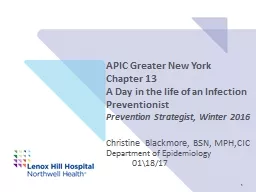PPT-APIC Greater New York Chapter 13
Author : trish-goza | Published Date : 2019-06-19
Journal Review C hristine Blackmore BSN MPHCIC Department of Epidemiology 021716 1 Month Day Year 2 Journal of the American Society of Radiologic Technologists
Presentation Embed Code
Download Presentation
Download Presentation The PPT/PDF document "APIC Greater New York Chapter 13" is the property of its rightful owner. Permission is granted to download and print the materials on this website for personal, non-commercial use only, and to display it on your personal computer provided you do not modify the materials and that you retain all copyright notices contained in the materials. By downloading content from our website, you accept the terms of this agreement.
APIC Greater New York Chapter 13: Transcript
Download Rules Of Document
"APIC Greater New York Chapter 13"The content belongs to its owner. You may download and print it for personal use, without modification, and keep all copyright notices. By downloading, you agree to these terms.
Related Documents














